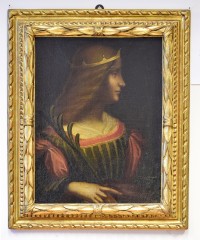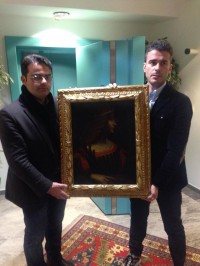 Italian financial police and the Carabinieri art theft squad teamed up with Swiss federal authorities Monday to seize a painting some believe to be a lost portrait of Isabella d’Este by Leonardo da Vinci from a bank vault in Lugano, Switzerland. Clandestine sale negotiations were ongoing when the police nabbed the work. The top asking price was 120 million euros ($135.9 million). Prosecutor Manfredi Palumbo said at a press conference that there are 70 people of interest in this investigation, all potentially part of a large illegal art smuggling ring attempting to move multiple works out of Italy into the black market.
Italian financial police and the Carabinieri art theft squad teamed up with Swiss federal authorities Monday to seize a painting some believe to be a lost portrait of Isabella d’Este by Leonardo da Vinci from a bank vault in Lugano, Switzerland. Clandestine sale negotiations were ongoing when the police nabbed the work. The top asking price was 120 million euros ($135.9 million). Prosecutor Manfredi Palumbo said at a press conference that there are 70 people of interest in this investigation, all potentially part of a large illegal art smuggling ring attempting to move multiple works out of Italy into the black market.
The painting was found as a result of a fortuitous encounter during an unrelated investigation last August. The finance police in Pesaro, a town on the northeast coast of Italy in the Marche region, were looking into an insurance fraud case when they discovered documents indicating the portrait was in Switzerland. The finance police teamed up with the Carabinieri and tracked down the painting in the private vault of a Lugano trust. There’s some raw footage of the bust here. All that teal makes for a pretty sad looking Swiss bank vault.
This isn’t the paintings first sojourn in a Swiss vault. When the news of it first emerged in October of 2013, the portrait was one of 400 artworks kept in a Swiss bank by an anonymous Italian family who claimed the collection had been in Switzerland since the early 20th century. Completely unpublished and undocumented, of course, because that’s how Swiss private collections like it. Family lore whispered of it being Leonardo’s portrait of Isabelle d’Este so finally around 2009 or so, likely in advance of sale, they began intensive research on the piece. Radiocarbon dating found that the work was painted between 1460 and 1650; X-ray fluorescence found that the primer and pigments are consistent with those used by the Renaissance master. UCLA emeritus art history professor and Leonardo expert Carlo Pedretti enthusiastically authenticated the portrait as Leonardo’s work.
 The question of whether Leonardo ever painted a portrait of Isabella d’Este has been much debated by art historians over the centuries. In December of 1499, Leonardo da Vinci fled Milan after the city was conquered by the French and his patron Duke Ludovico Sforza was overthrown. On the way to Venice, he stopped in Mantua where he was welcomed by Isabella d’Este, wife of Francesco II Gonzaga, Marquess of Mantua, who had met the artist at the double wedding where she married Francesco and her sister Beatrice d’Este married Ludovico Sforza. (Leonardo had actually designed some costumes for a joust held as part of the wedding celebrations.) He wasn’t in town for long, but Leonardo did make the time to draw a portrait of Isabella in black, red, white and ochre chalk on paper. He made at least two sketches of her portrait profile. One he took with him to Venice; the other he gave to Isabella’s husband Francesco Gonzaga. Multiple letters from Isabella to Leonardo asking him to make a painting from the sketch have survived, but there is no evidence that he ever did so. Isabella also asked him to make her another drawing after her husband gave hers away in 1501, but there’s no evidence he did that either. The sketch Leonardo gave to Gonzaga is now lost. The sketch he brought with him is now in the permanent collection of the Louvre.
The question of whether Leonardo ever painted a portrait of Isabella d’Este has been much debated by art historians over the centuries. In December of 1499, Leonardo da Vinci fled Milan after the city was conquered by the French and his patron Duke Ludovico Sforza was overthrown. On the way to Venice, he stopped in Mantua where he was welcomed by Isabella d’Este, wife of Francesco II Gonzaga, Marquess of Mantua, who had met the artist at the double wedding where she married Francesco and her sister Beatrice d’Este married Ludovico Sforza. (Leonardo had actually designed some costumes for a joust held as part of the wedding celebrations.) He wasn’t in town for long, but Leonardo did make the time to draw a portrait of Isabella in black, red, white and ochre chalk on paper. He made at least two sketches of her portrait profile. One he took with him to Venice; the other he gave to Isabella’s husband Francesco Gonzaga. Multiple letters from Isabella to Leonardo asking him to make a painting from the sketch have survived, but there is no evidence that he ever did so. Isabella also asked him to make her another drawing after her husband gave hers away in 1501, but there’s no evidence he did that either. The sketch Leonardo gave to Gonzaga is now lost. The sketch he brought with him is now in the permanent collection of the Louvre.
The discovery of an oil painting undeniably modeled after the drawing sparked much discussion as other experts disagreed with Pedretti’s attribution. One glaring issue is that the portrait is on canvas while Leonardo and his school used wood panels. This would be the only known work he ever did on canvas. It’s also a remarkably accurate match to the sketch considering that it was ostensibly painted years after the drawing was done (Pedretti posits that it was painted in 1514 when Leonardo met Isabella again in Rome). Then there are the quality concerns. Parts of it — the crown and that atrocious palm frond she’s holding — are clearly not the work of the master.
 Just to add another layer of labyrinthine complexity to this case, recall that the news of the Isabella portrait broke in the Corriere della Sera’s Sette magazine the first week of October, 2013. Less than two months earlier on August 27th, 2013, Pesaro police received a tip that a local lawyer, Sergio Shawo, was found in possession of a letter from one Emidia Cecchini, the 70-year-old putative owner of the portrait, in which she exhorts him to sell the painting for no less than 95 million euros ($107 million). By Italian law, all art works more than 50 years old cannot leave Italy without a special export license and there was no license pertaining to the portrait. Pesaro authorities asked their Swiss colleagues to execute a search warrant on the Swiss bank vault where the painting was believed to be kept, but they were unable to find it there.
Just to add another layer of labyrinthine complexity to this case, recall that the news of the Isabella portrait broke in the Corriere della Sera’s Sette magazine the first week of October, 2013. Less than two months earlier on August 27th, 2013, Pesaro police received a tip that a local lawyer, Sergio Shawo, was found in possession of a letter from one Emidia Cecchini, the 70-year-old putative owner of the portrait, in which she exhorts him to sell the painting for no less than 95 million euros ($107 million). By Italian law, all art works more than 50 years old cannot leave Italy without a special export license and there was no license pertaining to the portrait. Pesaro authorities asked their Swiss colleagues to execute a search warrant on the Swiss bank vault where the painting was believed to be kept, but they were unable to find it there.
So when all the big publicity about this incredible find in the Swiss vault was going down with the dueling experts and the lab testing and all that, as far as authorities were concerned at least, the painting was actively on the lam. Police suspected it had been smuggled back into Italy in a dastardly game of keep-away, and indeed it may have been before returning to Switzerland the next year where it cropped up in that insurance fraud case.
The painting is still in Switzerland for now where it will stay until legal ownership can be determined. Cecchini, the nice old lady in reduced circumstances whose grandparents put together so fine an art collection, may be the legitimate owner trying to win the lottery by the illegal export and sale of her property, or that whole 400 paintings in a Swiss vault since the early 1900s story may be a complete and total fabrication to cover an art smuggling conspiracy. Two art dealers are under investigation for involvement in this case, and they were looking to sell other Old Master works at the same time.
Once ownership is established, the Italian authorities want the painting back in Italy. Until then, additional authentication research is on hold.